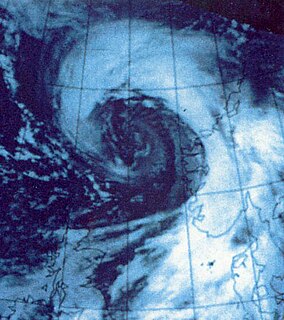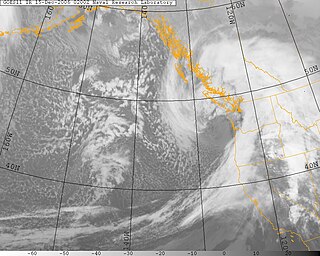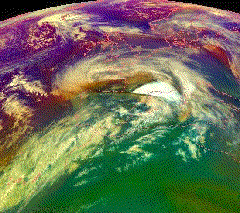These are some notable tornadoes, tornado outbreaks, and tornado outbreak sequences that have occurred around the globe.
- Exact death and injury counts are not possible; especially for large events and events before 1955.
- Prior to 1950 in the United States, only significant tornadoes are listed for the number of tornadoes in outbreaks.
- Due to increasing detection, particularly in the U.S., numbers of counted tornadoes have increased markedly in recent decades although the number of actual tornadoes and counted significant tornadoes has not. In older events, the number of tornadoes officially counted is likely underestimated.

The Burns' Day Storm was an extremely violent windstorm that took place on 25–26 January 1990 over north-western Europe. It is one of the strongest European windstorms on record. This storm has received different names as there is no official list of such events in Europe. Starting on the birthday of Scottish poet Robert Burns, it caused widespread damage and hurricane-force winds over a wide area. The storm was responsible for 47 deaths, although figures have ranged from 89 to over 100.

Lothar and Martin were violent European windstorms which swept across western and central Europe during a period of 36 hours in December 1999. The storms caused major damage in France, southern Germany, Switzerland, and Italy. Throughout the affected region, 140 people were killed and damage was estimated at €9.9 billion. Both of these storms were associated with an intense jet stream aloft and benefitted from latent heat release through atmosphere-ocean exchange processes. Lothar and Martin together left 3.4 million customers in France without electricity, and forced EdF to acquire all the available portable power generators in Europe, with some even being brought in from Canada. These storms brought down a quarter of France's high-tension transmission lines and 300 high-voltage transmission pylons were toppled. It was one of the greatest energy disruptions ever experienced by a modern developed country.

Anatol is the name given by the Free University of Berlin to a powerful winter storm that hit Denmark, Southwest Sweden, and Northern Germany on December 3, 1999. The storm had sustained winds of 146 km/h and wind gusts of up to 184 km/h, equivalent to an intense category 1 hurricane, which is unusually strong for storms in northern Europe. The storm caused 20 fatalities, and over 800 injuries in Denmark.
The name Emma has been used for nine tropical cyclones in the northwest Pacific Ocean.

The New Year's Day Storm was a powerful European windstorm that affected much of northern Scotland and western Norway on 1 January 1992. DNMI estimated the strongest sustained winds and the strongest gusts to have reached 90 knots (46 m/s) and 62 m/s, respectively. Unofficial records of gusts in excess of 130 knots (67 m/s) were recorded in Shetland, while Statfjord-B in the North Sea recorded wind gusts in excess of 145 knots (75 m/s). There were very few fatalities, mainly due to the rather low population of the islands, and the fact that the islanders are used to powerful wind, and because it struck in the morning on a public holiday when people were indoors. In Norway there was one fatality, in Frei, Møre og Romsdal county. There were also two fatalities on Unst in the Shetland Isles.

Cyclone Klaus was a European windstorm or cyclone which made landfall over large parts of central and southern France, Spain and parts of Italy in January 2009. The storm was the most damaging since Lothar and Martin in December 1999. The storm caused widespread damage across France and Spain, especially in northern Spain.

Cyclone Quimburga, also referred to as the Lower Saxony Storm was a deadly European windstorm that struck northern and central Europe between 12–14 November 1972. The storm has been described as one of the most devastating storm events during the 20th century.

Pacific Northwest windstorms, sometimes colloquially known as Big Blows, are extratropical cyclones which form in the Pacific basin, and affect land areas in the Pacific Northwest of the United States and British Columbia, Canada. They form as cyclonic windstorms associated with areas of low atmospheric pressure that track across the North Pacific Ocean towards western North America. Deep low pressure areas are relatively common over the North Pacific. They are most common in the winter months. On average, the month when most windstorms form is December.
The 2016–17 UK and Ireland windstorm season was the second instance of the United Kingdom's Met Office and Ireland's Met Éireann naming extratropical cyclones. Substantially less active than the previous season, the season succeeded the 2015–16 UK and Ireland windstorm season and preceded the 2017–18 European windstorm season.
The 2017–18 European windstorm season, or the 2017–18 UK and Ireland windstorm season was the third instance of the United Kingdom's Met Office and Ireland's Met Éireann naming of high impact extratropical cyclones and the first instance of Spanish, Portuguese and French naming as well. This season was also the deadliest windstorm season for the UK and Ireland since official naming began in 2015. In addition, a major amount of the season's damage was due to two of its storms – Emma and Ophelia and the "Beast from the East" cold wave. The first system, Storm Aileen, formed on 12 September. The season also featured Hurricane Ophelia, which impacted the Azores, Portugal and Spain, before it transitioned into an extratropical cyclone and impacted the United Kingdom and Ireland. Storm Brian struck Ireland less than a week later, resulting in three further fatalities.

Cyclone Egon was a European windstorm that affected the north of France, Belgium and Germany during the night of Thursday 12 to Friday 13 January 2017. It caused three deaths, widespread power outages, and wind damage and significant snowfall, primarily France and Germany, but also in the Benelux states, Austria and Switzerland.

Cyclone Burglind was an extratropical cyclone and European windstorm that affected Ireland, the United Kingdom, France, Benelux, Germany, Austria and Switzerland on the 2–3 January 2018. The storm caused extensive damage and traffic disruption. It was given the name Eleanor by Met Éireann and the UK Met Office, while the Free University of Berlin named the low pressure Burglind.

Cyclone Zeus was an extratropical cyclone and European windstorm which affected France on 6–7 March 2017. The storm developed rapidly and moved quickly across France on a north-west/south-east trajectory from Finistère in Brittany to the Alpes-Maritimes then Corsica. The storm's rapid strengthening resulted in much stronger winds than initially expected, with a maximum gust of 193 kilometres per hour (120 mph) recorded in Camaret-sur-Mer, Finistère.
The 2019–20 European windstorm season is the fifth instance of seasonal European windstorm naming in Europe. However, this is the first time that the Netherlands will participate, joining the United Kingdom and Ireland's meteorological agencies. The new seasons storm names will be released on 2nd September 2019. In July 2019, it was announced that storm seasons would run form 1st September to 30th August, meaning any storms named in this period will be named using the 2019—20 storm list. Previously, the storm seasons lasted from 1st July to 30th June. The Portuguese, Spanish and French meteorological agencies will again collaborate too.











